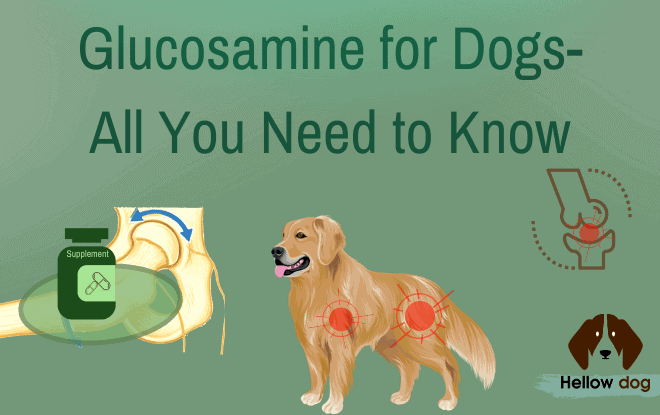As a dog ages, the energy levels drop down, and the vitality of life fades away. The slow-down symptoms observed in dogs due to old age can be an indication of joint pain in them. Joint pain can make the dog unwilling to move around, and go out for a walk. But, regular exercise is a necessity for the maintenance of healthy muscles, joints, and bones. Inactivity of your dog can lead to further pain, and severity of the situation, i.e., muscle stiffness.
As we require vitamin D supplements to overcome arthritis pain, similarly glucosamine for dogs is given as a supplement to cover up the damage. It helps to restore cartilage and, therefore, the dog’s active lifestyle is prolonged.
What is the Need For Glucosamine Supplement?
Glucosamine is naturally found in high concentrations in the healthy cartilage of an animal’s body. The natural substance glucosamine, found in a dog’s body, produces glycosaminoglycan. It is used for forming and repairing body tissues, the cartilage. Cartilage is the sponge-like moist material that cushions the smooth movements of joints.
With aging, the production of glucosamine is slowed down which results in the gradual repair of cartilage at joints. It leads to stiffness and pain in joints. Such a slow repair process leads to the tearing of joints due to friction during the dog’s movements. The degenerating bones are responsible for the joint disease, arthritis.
The cycle of joint degeneration begins when the cartilage at joints rub against each other during movements. The cartilage gets damaged and inflamed, which leads to the further release of damage-causing enzymes.
How is Glucosamine Produced?
In 1876, glucosamine was first isolated and cultured by German surgeon, Georg Ledderhose. The three common glucosamine formulations are N-Acetyl-Glucosamine (NAG), glucosamine sulfate, and glucosamine hydrochloride.
Glucosamine Sulphate: It’s commonly used in supplements. The glucosamine sulfate is usually found in shellfish or is synthesized in the labs. The sulfur components function by building and repairing the cartilage in the dog’s joints.
Glucosamine Hydrochloride: It is commonly found in shellfish that are devoid of sulfate components. It is present in concentrated amounts. Studies have shown that glucosamine HCL is less effective for the joint reparation process.
N-Acetyl-Glucosamine (NAG): It’s derived from glucose, which is a precursor for hyaluronic acid in the body. Hyaluronic acid is a part of synovial fluids that are joint lubricants. NAG has dual functions: for repairing joints, and for curing gastrointestinal issues.
For commercial preparations of the supplement, the ingredients are extracted from shells of sea animals like oysters, shrimps, and crabs, or are specially synthesized in laboratories having plant sources.
Glucosamine is available as chewable flavored tablets that can be included in dog food like pill pockets. They can also be given to dogs that are at risk of developing joint disease and injury—including hyperactive dog breeds.
What are the Benefits of Glucosamine?
Glucosamine positively affects relieving joint pain as it is anti-inflammatory in action. It helps to lubricate the abrasive joints and increase mobility by easing the movements of dogs for physical activities. It’s a natural cure for arthritis with rare side effects. The supplements replace the need for taking pain-relieving NSAIDs, which do not repair dogs’ joints and have side effects. The supplement does not react with other medications, supplements, and foods, which reduces the chances of possible side effects.
Common joints affected by arthritis are the hip, shoulder, elbow, carpus, intervertebral discs, and knee. The supplement is effective for alleviating pain caused by hip dysplasia, spinal disc injury treatments, joint surgery, and other bone operations.
In addition to other benefits, you can give glucosamine as a preventive measure that will reduce the chances of giving your dog painkillers later on. If you take action in time, you can save money by avoiding the expenditure on painkillers.
The owners continue to enjoy the dog’s peak performance. Or else, it’s quite difficult for the owner to see their furry ball in pain, and be unable to run around the house happily. If the dog suffers from a stomach disorder, you can think about giving your dog probiotics.
Similar Topics: Dog Hip Dysplasia – What Steps Can Be Taken to Ease the Pain
What are the Various Components of Glucosamine?
Glucosamine is the main ingredient of joint health supplements, and other components are chondroitin and MSM (Methylsulphonylmethane).
Chondroitin is naturally found in dog cartilage, and when it pairs with glucosamine, then, it has higher benefits for the joints. Chondroitin sulfate is a naturally occurring substance that helps the cartilage to retain fluids in joint bones. Other sources of chondroitin are cow and shark cartilage.
MSM (Methylsulphonylmethane) is a sulfur-containing compound that’s proven to improve the health of joints and their mobility.
Together, all these three components enhance the power of joints and reduce the pain due to inflammatory joints.
What are the Dose Requirements?
To fully benefit from the pain in joints, the dog will begin with a ‘loading dose’ for the first few weeks, and, then, decrease it to a ‘maintenance dose.’ However, unfortunately, the melatonin supplement has to continue for life because it provides an essential substance produced by the body. Otherwise, after some weeks of discontinuing the supplement, the wear and tear of joints lead to pain.
To fully benefit from the pain in the joint, the dog will begin with a ‘loading dose’ for the first few weeks, and, then, decrease it to a ‘maintenance dose.’ However, unfortunately, the melatonin supplement has to continue for life because it provides an essential substance produced by the body. Otherwise, after some weeks of discontinuing the supplement, the wear and tear of joints lead to pain.
The dose of glucosamine for dogs depends upon the ingredients it contains and the size of the dog. Manufacturers’ guidelines and the vet’s recommendations are important to be considered. Most dogs react perfectly to only glucosamine. The dosage according to the dog’s weight is:
- Below or About 15 kg weight: A single capsule of 750 mg glucosamine: Every two days
- From 15 to 30 kg weight: A single capsule of 750 mg glucosamine: Every day
- From 30 to 40 kg weight: Single or double capsules of 750 mg glucosamine: Every day
- About or above 40 kg weight: Double capsules of 750 m glucosamine: Every day
If the joint problem isn’t resolved, your vet may recommend supplements with added chondroitin. The dosage requirement will stay the same.
You can enjoy the hyperactivity of your pooch for longer, which includes a willingness to play, go out for a walk, and happily move around the house.
The side effects of glucosamine are mild including diarrhea, etc. However, the side effects can vary from dog to dog, so if you notice any behavior change in your pooch, it’s important to withdraw the use of glucosamine and consult the vet.
How Does Glucosamine Function?
The exact mechanism of action of glucosamine cannot be tracked, but it is an amino sugar that perks up the production of glycosaminoglycans, the major building block of a dog’s cartilage. The supplement fuels the activity of DNA or chondrocytes that are involved in the protection of joints against cartilage degradation.
Can Human Glucosamine Be Given to Dogs?
Glucosamine supplements mainly contain amino sugar, whether it’s for dogs or humans; but the other ingredients differ.
The human supplement can only benefit the joint problem in dogs if it’s purely glucosamine in essence and is available in liquid or powder form. The right dosage has to be given to dogs. It should be kept in mind that pet-designed supplements are the best versatile cure for them, and no human supplement can provide wholesome benefits.
Glucosamine for humans is prepared to be swallowed. Then, it gets dissolved in the digestive tract. Human supplements take time for absorbing. The digestive tract of humans is longer than dogs, so the time for dissolution is a considerable one.
But, the digestive lining is smaller in dogs, and the dog supplement is chewable before getting swallowed for quick absorption in the digestive tract. The chewing of tablets allows the nutrient to get absorbed with ease. Moreover, dog supplements are flavored with cheese or bacon taste.
Arthritis is a common joint problem that makes glucosamine a necessity.
Read: Early Signs that Indicate Your Dog has A Health Problem
What are the Symptoms of Arthritis?
Dogs are used to hide their joint pain initially due to their defense mechanisms. Joint pain or joint degeneration can be recognized in dogs when the dog shows following symptoms:
1. A decreased level of activity
2. An overpowering lethargy or lack of energy for long walks or play
3. The hip joints are mostly soft when felt.
4. A restless sleep due to difficulty in movement.
How Can Arthritis be Treated?
Firstly, consult the vet to get the problem rightly identified before any medication. The vet will provide tailored advice for dogs to perfectly fit their requirements. Besides that, you have to make the dog comfortable by providing a healthy and balanced diet. You also have to reduce the portion size according to the daily activity level of the dog. You have to give them full rest to recover the damage, as the natural glucosamine production is slow. In old age, supplements like glucosamine and vitamins have to be added to the diet to cope with slow body processes.







